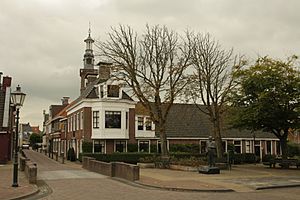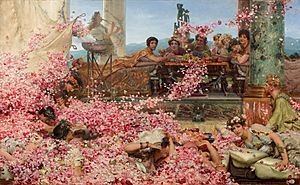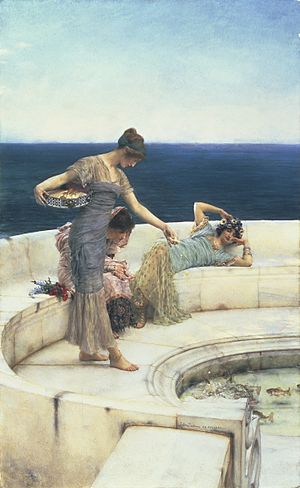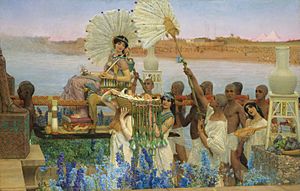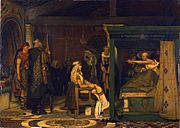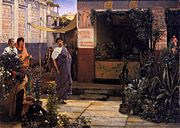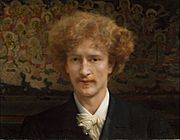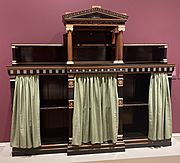Lawrence Alma-Tadema facts for kids
Quick facts for kids
Lawrence Alma-Tadema
|
|
|---|---|
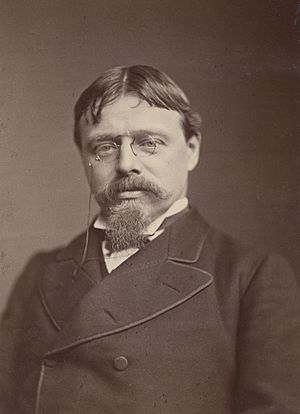
Alma-Tadema in 1870
|
|
| Born |
Lourens Alma Tadema
8 January 1836 Dronryp, Waadhoeke, Netherlands
|
| Died | 25 June 1912 (aged 76) |
| Nationality | Dutch British denizen |
| Known for | Painting |
| Movement | Academicism |
| Spouse(s) |
|
| Awards | Order of Merit Royal Academician |
Sir Lawrence Alma-Tadema (born Lourens Alma Tadema; 8 January 1836 – 25 June 1912) was a famous Dutch painter. He later moved to the United Kingdom. He became known for his paintings of ancient Rome. These paintings often showed fancy homes and beautiful blue seas.
Alma-Tadema was very popular during the Victorian era. After he died, his art was not as well-liked. But since the 1960s, people have started to appreciate his work again.
Contents
Biography
Early Life and Artistic Beginnings
Lourens Alma Tadema was born on January 8, 1836. He grew up in a village called Dronryp in the Netherlands. His last name, Tadema, means 'son of Tade'. His first names, Lourens and Alma, came from his godfather. He was the sixth child in his family.
In 1838, his family moved to Leeuwarden. His father was a notary, which is like a lawyer who deals with legal documents. When Lourens was four, his father passed away. His mother, who liked art, made sure her children had drawing lessons. Lourens had his first art lessons from a local teacher.
His family wanted him to become a lawyer. But in 1851, when he was fifteen, he became very ill. Doctors thought he would not live long. So, they let him spend his time drawing and painting. Surprisingly, he got better and decided to become an artist.
Studying Art in Belgium
In 1852, Alma-Tadema joined the Royal Academy in Antwerp, Belgium. There, he studied old Dutch and Flemish art. He won many awards during his four years at the academy.
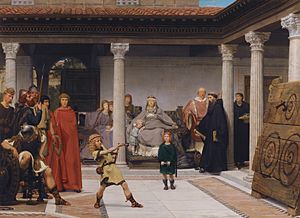
After the academy, he worked as an assistant to a painter named Louis Jan de Taeye. De Taeye taught him a lot about history and costumes. This made Alma-Tadema want to paint historical scenes. He learned to make his paintings very accurate.
In 1858, Alma-Tadema started working with Baron Jan August Hendrik Leys. Leys was a very respected painter in Belgium. Under Leys's guidance, Alma-Tadema painted his first big work, The Education of the Children of Clovis (1861). This painting was a big hit with critics and artists. It helped him become famous. Leys did tell him that his marble in the painting looked like cheese!
Alma-Tadema took this criticism seriously. He worked hard to paint marble and stone perfectly. He became known as the best painter of these materials. The Education of the Children of Clovis was even bought by King Leopold of Belgium.
Early Works and Family Life
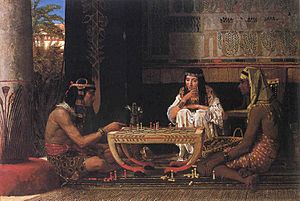
At first, Alma-Tadema liked to paint scenes from the Merovingian period (an early French dynasty). But these themes were not popular everywhere. So, he started painting scenes from ancient Egypt. These were much more popular. By 1862, he had his own studio and was a well-known artist.
In 1863, Alma-Tadema's mother passed away. Later that year, he married Marie-Pauline Gressin-Dumoulin de Boisgirard. She was the daughter of a French journalist. Alma-Tadema painted her portrait a few times. They had three children, but their only son died young. Their two daughters, Laurence and Anna, both became artists. Laurence was a writer, and Anna was a painter.
Alma-Tadema and Pauline went to Italy for their honeymoon. They visited Florence, Rome, Naples, and Pompeii. He loved the ruins of Pompeii. This trip made him want to paint scenes from ancient Greece and Rome. He even met an Italian painter who helped him make his ancient scenes very accurate.
In 1864, he met Ernest Gambart, a very important art dealer. Gambart was so impressed with Alma-Tadema's work that he ordered twenty-four paintings. He also arranged for Alma-Tadema's art to be shown in London.
In 1869, Pauline died from smallpox. Alma-Tadema was very sad and stopped painting for months. His sister, Artje, helped take care of his two young daughters.
Later that year, Alma-Tadema became ill. His doctor suggested he go to England for treatment. In London, he met Laura Theresa Epps, who was 17. He fell in love with her right away.
Moving to England
In July 1870, the Franco-Prussian War started. This made Alma-Tadema decide to move to London. He also wanted to be closer to Laura Epps. He said he moved because he loved London and his art sold well there.
He arrived in London in September 1870 with his daughters and sister. He quickly contacted Laura and offered to give her painting lessons. During one lesson, he asked her to marry him. Laura's father was not sure at first because Alma-Tadema was 34 and Laura was 18. But he agreed if they waited to get to know each other better. They married in July 1871. Laura also became a well-known artist. She appeared in many of Alma-Tadema's paintings. This marriage was happy, and Laura became a stepmother to Anna and Laurence.
In England, he changed his name to Lawrence Alma-Tadema. He also added "Alma" to his last name. This made his name appear earlier in art show lists, under "A" instead of "T".
A Famous Victorian Painter
Once in England, Alma-Tadema's career continued to grow. He became one of the most famous and highest-paid artists of his time. In 1871, he met many important Pre-Raphaelite painters. Their influence made his paintings brighter and more colorful.
In 1872, he started numbering his paintings. This system helped keep track of his works and made it harder for fake paintings to be sold. His first painting, from 1851, was Opus I. His last painting, finished just before he died, was Opus CCCCVIII.
In 1873, Queen Victoria gave Alma-Tadema and his wife special rights as British "Denizens." This meant they had some rights like British citizens. In 1876, he rented a studio in Rome. He often visited ancient ruins and bought many photos of them. He used these photos to make his paintings very accurate.
One of his important paintings from this time was An Audience at Agrippa's (1876). He was so good at painting that when someone wanted a similar painting, he just turned the emperor around in After the Audience.
In 1879, Alma-Tadema became a Royal Academician. This was a very important honor for him. In 1882, a big show of his 185 paintings was held in London.
In 1883, he went back to Rome and Pompeii. More ruins had been uncovered since his last visit. He spent a lot of time studying the sites every day. This gave him many ideas for his paintings. He sometimes put so many objects into his paintings that they looked like museum catalogs.
One of his most famous paintings is The Roses of Heliogabalus (1888). To paint the roses accurately, he had fresh roses sent to his London studio every week for four months!
Alma-Tadema also painted portraits, landscapes, and watercolors. He even made some etchings.
Personality and Later Years
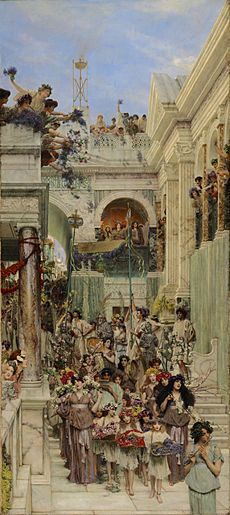
Even though his paintings were serious, Alma-Tadema had a playful side. He liked to play jokes and could get angry quickly, but then smile just as fast.
He was a very warm and friendly person. He was also a perfectionist and worked very hard. He was a good businessman and became one of the richest artists of his time. He was firm about money and the quality of his work. He was a cheerful man who enjoyed life.
Alma-Tadema painted less as he got older, partly due to his health. He also spent a lot of time decorating his new home, which he moved into in 1883. Still, he kept showing his art and winning awards. In 1899, he was made a knight in England. He was only the eighth artist from outside Britain to get this honor.
He also designed costumes for plays and made furniture, illustrations, and textiles. He even designed frames for his paintings. These other interests often appeared in his art. For example, he used his own furniture designs in his paintings. He also designed the clothes for the women in his art.
Between 1903 and his death, he painted less. But he still created big paintings like The Finding of Moses (1904).
On August 15, 1909, his wife Laura died at 57. Alma-Tadema died less than three years later, on June 28, 1912, at age 76. He passed away in Wiesbaden, Germany, where he was getting medical treatment. He was buried in St Paul's Cathedral in London.
Style
Alma-Tadema's paintings are famous for how well he painted flowers, fabrics, and shiny things like metal, pottery, and especially marble. People even called him the 'marbellous painter' because his marble looked so real. His work showed the great skill and bright colors of old Dutch masters.
From early on, Alma-Tadema cared a lot about making buildings in his paintings look correct. He often included objects he saw in museums, like the British Museum in London. He also read many books and collected many photos of ancient sites in Italy. He used these to make sure every detail in his paintings was accurate.
Alma-Tadema was a perfectionist. He worked very hard on his paintings, often redoing parts until they met his high standards. He was careful with every detail and line in his art. For many objects, he would paint what was right in front of him. He even had fresh flowers sent from far away to make sure they were perfect before they wilted. This dedication to truth made him famous.
Alma-Tadema's art has been linked to European Symbolist painters. He influenced artists like Gustav Klimt. These painters used classical ideas and unusual ways of arranging their paintings, just like Alma-Tadema.
Reputation

Alma-Tadema was one of the most popular painters of the Victorian era. He was also one of the richest. For over sixty years, he gave people what they wanted: detailed paintings of beautiful people in ancient settings. His accurate scenes of ancient Rome, with people relaxing on white marble in bright sunlight, showed a world people dreamed of.
After his death, his art became less popular. Some critics even called him "the worst painter of the 19th century." His paintings were not valued much for many years. But since the 1960s, people have started to appreciate his work again. He is now seen as a very important painter of classical scenes. His art shows how much people in his time wanted to imagine the past.
Alma-Tadema's careful research into ancient Rome made his paintings very useful for Hollywood movies. Directors used his art as inspiration for films like Intolerance (1916), Ben Hur (1926), Cleopatra (1934), and The Ten Commandments (1956). The designers for the movie Gladiator also used his paintings for ideas. His art even inspired the design of Cair Paravel castle in The Chronicles of Narnia: The Lion, the Witch and the Wardrobe (2005).
In 1962, an art dealer showed Alma-Tadema's work for the first time in 50 years. This helped bring back interest in his art. A TV show creator named Allen Funt collected many of his paintings when they were not popular. Later, he had to sell his collection. This sale in 1973 helped bring Alma-Tadema's art back into the spotlight.
One of his famous paintings, The Finding of Moses (1904), was once hard to sell. But in 1995, it sold for £1.75 million. In 2010, it sold for over $35 million, setting a new record for his work! Another painting, The Meeting of Antony and Cleopatra: 41 BC, sold for $29.2 million in 2011.
Alma-Tadema's painting The Tepidarium (1881) is in the book 1001 Paintings You Must See Before You Die. A special blue plaque was put on his home in London in 1975. It marks where he lived from 1886 until he died in 1912.
Archives
The Cadbury Research Library at the University of Birmingham has many of Alma-Tadema's old letters, artworks, and photos.
Gallery
-
Fredegund by the Deathbed of Bishop Praetextatus, 1864
-
Portrait of Ignacy Jan Paderewski, 1891
See also
 In Spanish: Lawrence Alma-Tadema para niños
In Spanish: Lawrence Alma-Tadema para niños



